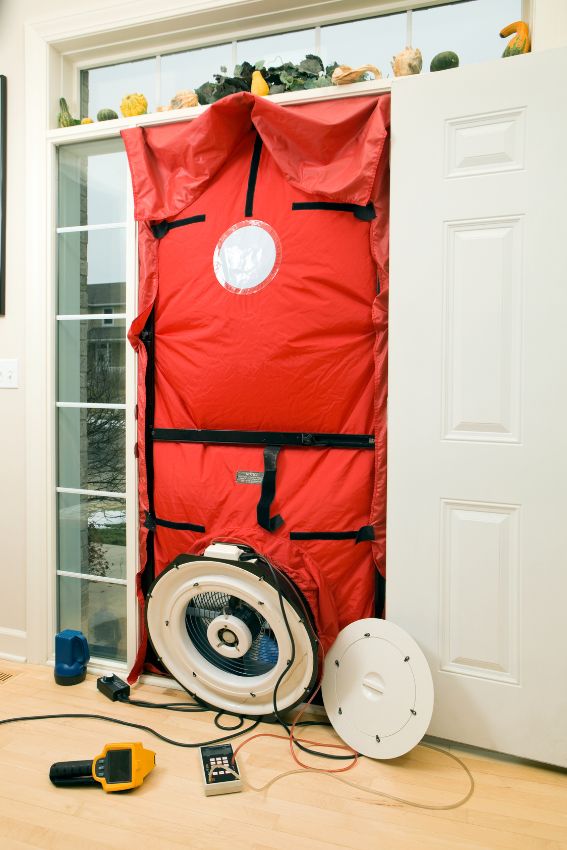Cut monthly energy bills with precision upgrades through energy testing
Cut monthly energy bills with precision upgrades through energy testing
Blog Article
The Role of Power Testing in Attaining an Airtight Option for Your Residential or commercial property
Energy screening is important for residential or commercial property owners looking for to produce an airtight setting. It determines air leaks and inadequacies that can jeopardize power efficiency. Typical wrongdoers include voids around windows and doors. Using approaches like blower door tests and thermal imaging, home owners can obtain understandings right into their property's vulnerabilities (energy testing). Comprehending these searchings for is important. What actions should be taken once air leaks are recognized? The answers hold the trick to enhanced comfort and financial savings
Understanding Energy Screening and Its Importance
Energy testing plays a necessary function in evaluating the airtightness of buildings and structures. By determining air leakage, this approach offers essential insights into a home's energy effectiveness, thermal comfort, and general performance. Airtight buildings minimize power usage, ensuring that cooling and heating systems operate effectively. This testing process usually entails techniques such as blower door examinations, which create a regulated environment to determine unintentional air pathways.Understanding the relevance of power screening expands past conformity with building regulations; it promotes a proactive strategy to sustainability. Identifying air leaks early can lead to timely removal, eventually enhancing interior air quality and reducing energy costs. In addition, power screening adds to the longevity of building products by minimizing moisture build-up and related damages. As recognition of environmental influence boosts, energy screening ends up being a vital device for home builders and home owners intending for high-performance buildings.
Usual Sources of Air Leaks in Feature
Determining common sources of air leakages is crucial for enhancing a home's power efficiency. These leaks typically happen in different areas of a structure, considerably influencing heating & cooling expenses. Typical perpetrators include gaps around doors and home windows, where seals might degrade over time. Additionally, electric outlets and switches can produce pathways for air exchange if not correctly protected. Attics and cellars are also frequent resources, specifically where wall surfaces meet the structure or the roof covering. Various other prospective leak factors consist of plumbing penetrations, venting systems, and the areas surrounding smokeshafts. Older properties might endure from degraded structure products, enhancing vulnerability to air seepage. By identifying these common sources, homeowner can take positive steps to seal leaks, thus improving general power effectiveness and comfort within their spaces. Attending to these concerns is an essential part of establishing an impermeable solution for any type of property.
Approaches of Power Screening: Blower Door and Thermal Imaging
Reliable energy testing techniques, such as blower door examinations and thermal imaging, play an important duty in diagnosing air leaks within a residential or commercial property. The blower door test entails depressurizing a building or pressurizing to gauge air movement and determine leakages. A calibrated fan is mounted in an outside entrance, and the resulting pressure distinction highlights locations of undesirable air infiltration. This approach quantifies the total airtightness of the structure.Thermal imaging enhances blower door examinations by visually discovering temperature level variants on surfaces, revealing surprise air leaks. Infrared video cameras catch heat loss or gain, permitting accurate recognition of issue locations, such as poorly protected wall surfaces or gaps around doors and windows. energy testing south carolina. With each other, these approaches supply a comprehensive evaluation of a residential or commercial property's energy efficiency, enabling building owners to deal with air leakages properly and boost general efficiency
Advantages of Identifying Air Leaks
Recognizing air leaks provides substantial benefits for power performance and interior convenience. By sealing these leakages, buildings can lower energy usage, causing lower energy costs and a lowered carbon impact. Furthermore, boosted airtightness contributes to a much more secure indoor environment, enhancing total convenience for residents.
Energy Performance Improvements
Identifying air leakages is essential for enhancing power efficiency in buildings. Determining these leakages enables building proprietors to resolve locations where conditioned air leaves or unconditioned air enters, leading to substantial energy financial savings. By sealing spaces and fractures, structures can maintain a consistent temperature level, lowering the need on home heating and cooling down systems. This not only lowers power bills however additionally minimizes the environmental impact connected with enhanced power usage. In addition, energy effectiveness enhancements add to a structure's overall sustainability, making it a much more eye-catching alternative for eco-conscious customers or occupants. Ultimately, focusing on air leak detection and remediation helps maximize power use, promotes liable resource monitoring, and supports long-term financial advantages for residential property owners.

Boosted Indoor Comfort
Resolving air leakages not only brings about power savings however additionally considerably enhances indoor convenience. When air leaks are properly identified and secured, temperature level guideline within a residential or commercial property comes to be extra reliable. This results in consistent indoor temperature levels, eliminating cold drafts in winter months and warm places in summertime. Enhanced insulation additionally decreases sound pollution from outdoors, creating a quieter and more peaceful living atmosphere. Furthermore, improved air top quality is accomplished by lessening the why not try these out infiltration of exterior toxins, irritants, and humidity, adding to the general wellness of passengers. Home owners experience an even more positive atmosphere, cultivating leisure and efficiency. Inevitably, recognizing and correcting air leakages is important for achieving suitable indoor convenience throughout the year.
How Energy Testing Enhances Convenience and Indoor Air Quality
Energy testing plays a necessary role in boosting temperature level policy within interior rooms, ensuring a constant and comfy atmosphere. By sealing and identifying air leaks, it additionally substantially reduces the infiltration of pollutants, thereby boosting indoor air quality. This twin effect promotes total well-being for passengers.
Improved Temperature Regulation
Reliable temperature guideline considerably adds to both comfort and interior air high quality, making it a crucial emphasis for modern-day structure style. Power testing plays a vital role in accomplishing this regulation by recognizing areas where heat loss or gain takes place, enabling targeted improvements. By ensuring an impermeable building envelope, energy testing helps maintain constant indoor temperatures, decreasing the requirement for excessive heating or cooling. This security enhances passenger convenience, as fluctuations in temperature can cause pain and discontentment. Furthermore, efficient temperature level control can improve indoor air high quality by minimizing the risk of condensation and mold development, which flourish in uneven temperature conditions. Energy screening is important for optimizing temperature administration in commercial and household properties.
Lowered Pollutant Infiltration
While lots of factors contribute to interior air high quality, decreased pollutant seepage attracts attention as an essential facet that energy screening can significantly boost. Power screening identifies air leaks and powerlessness in a structure's envelope, which may enable exterior contaminants, allergens, and moisture to enter interior spaces. By securing these leaks, residential or commercial properties can properly limit airborne impurities, leading to a healthier atmosphere. Boosted airtightness not only boosts comfort yet also reduces the burden on home heating and cooling systems, resulting in power financial savings. Furthermore, minimized contaminant seepage promotes much better total well-being for passengers, as cleaner air promotes respiratory health and reduces allergic reaction symptoms. Power screening plays a critical role in developing both an energy-efficient and health-conscious living room.
The Financial Impact of Energy Screening on Energy Costs

Steps to Take After Power Screening Results
When power testing outcomes remain in, property owners must meticulously evaluate the findings to establish one of the most reliable path forward. The very first step involves identifying the areas that call for improvement, such as air leakages or insulation shortages. House owners should after that focus on repair work based on the severity of the issues and their potential effect on energy efficiency.Next, it is advisable to speak with specialists who concentrate on energy effectiveness to create an extensive activity plan. This might include options like sealing spaces, including insulation, or updating home windows and doors.After applying the required adjustments, a follow-up energy test can determine the performance of the repairs. Continuous surveillance is likewise vital to assure that the residential or commercial property preserves its airtight status over time. By following these steps, home owners can significantly boost their property's power performance, leading to lowered energy costs and improved convenience.
Often Asked Questions
Exactly how Usually Should I Conduct Energy Examining on My Property?
The frequency of energy testing need to generally be every couple of years, or adhering to substantial remodellings. Routine assessments help identify efficiency enhancements and guarantee that the residential property preserves perfect energy performance gradually, adjusting to changing problems.
Is Power Screening Necessary for New Constructions?
Power testing is vital for brand-new buildings, as it determines possible air leak and insulation issues - air tight solutions. Implementing these examinations assurances energy effectiveness, boosts Look At This interior comfort, and satisfies building ordinance, inevitably leading to long-lasting price financial savings
Can I Carry Out Power Screening Myself?
Power screening generally needs customized devices and experience. While some homeowners may attempt basic analyses, expert services guarantee exact outcomes and effective identification of issues, inevitably resulting in far better power performance and convenience in living rooms.
What Is the Cost of Professional Power Screening Services?
The price of specialist energy screening solutions commonly varies from $300 to $1,500, depending upon home size, intricacy, and place. House owners must think about potential power cost savings when evaluating the financial investment in these services.
For How Long Do Power Screening Outcomes Usually Last?
Energy testing results typically continue to be legitimate for one to 3 years, depending on variables like structure alterations and environmental changes. Regular updates are advised to assure accuracy and maintain reliable power efficiency standards. Reliable power screening methods, such as blower door examinations and thermal imaging, play a crucial function in detecting air leaks within a residential or commercial property. Recognizing these leaks allows property owners to attend to areas where conditioned air gets away or unconditioned air gets in, leading to significant power financial savings. Power screening determines air leakages and weak points in a structure's envelope, which might enable outside contaminants, irritants, and dampness to go into interior rooms. As property owners increasingly look for to lower their energy expenditures, the role of energy testing ends up being important in determining leaks and inadequacies. Property owners should after that prioritize repair services based on the seriousness of the problems and their possible influence on power efficiency.Next, it is a good idea to seek advice from with professionals who specialize in energy performance to design an extensive action strategy.
Report this page